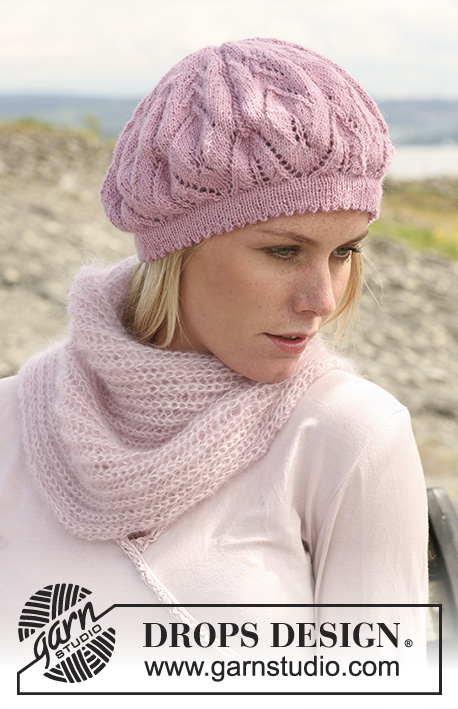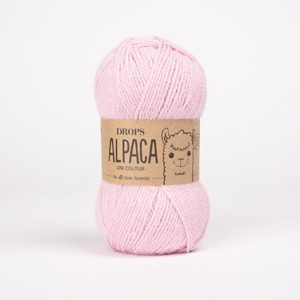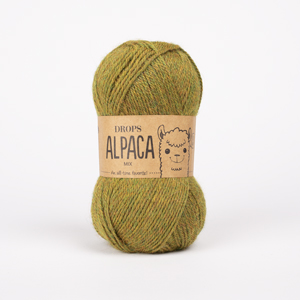Comments / Questions (113)
![]() Aline wrote:
Aline wrote:
Hallo, ich würde gerne diese Mütze mit Alpaca plus Kid Silk fertigen. Wie rechne ich um? DROPS 242-1 stimmt für dieses Garn ziemlich perfekt in der kleineren Grösse für eine 54/56 Kann ich die Angaben daraus auf dieses Pattern anwenden? LG
11.12.2024 - 19:58DROPS Design answered:
Liebe Aline, die Maschenprobe bekommen Sie wahrscheinlich nicht wenn Sie diese Mütze 2-fädig stricken; dann sollen Sie die ganze Anleitung nach Ihrer eigenen Maschenprobe und gewünschte Größe umrechnen. Viel Spaß beim Stricken!
12.12.2024 - 09:35
![]() Maria Taub wrote:
Maria Taub wrote:
Please explain the increases at the beginning and end of rows 3-11 in the diagram. As far as I understand, one ends with 10 stitches more due to the increases at both sides of the pattern. There are 8 decreases at the end of rows 33-60 not 10. I am confused. Thanks
29.08.2022 - 20:45DROPS Design answered:
Dear Maria, you need to increase stitches between each repeat of the pattern on the round. After the last increase, in row 11, you should have 220 stitches on the round (you increase 10 stitches on each of the 10 12-stitch repeat). You need to decrease on each side of the diagram, so you have 16 decreases, not 8. In the end, you decrease 160 stitches in the round. So 220-160 are 60 stitches after finishing M.1. Happy knitting!
30.08.2022 - 01:03
![]() Maria Taub wrote:
Maria Taub wrote:
Entiendo que debo repetir el diseño 10 veces antes de comenzar las disminuciones. Las instrucciones leen: "Después de M.1 debe tener 60 pts en la vta. Trab 1 vta ..." ¿Por qué no 120 pts.? Yo creo que debe haber 60 pts después de la primera corrida de disminuciones. ¿Se disminuye 2pjd + 2pjd, etc , una vta punto jersey, otra corrida con disminuciones y después se toman los puntos restantes? ¿Cuántos puntos se toman con una aguja? Mil gracias por su ayuda.
29.08.2022 - 16:55DROPS Design answered:
Hola Maria, trabajas M.1 10 veces en la vuelta, no en vertical. Empiezas M.1 con 120 pts (10 repeticiones en la vuelta del diagrama de 12 pts). Después trabajas las disminuciones (incluidas en el diagrama). Al terminar las disminuciones (y M.1), debes tener 10 repeticiones en la vuelta de 6 pts del diagrama M.1.
30.08.2022 - 00:59
![]() Gabriele Zehner wrote:
Gabriele Zehner wrote:
Sorry wollte keinen Kommentar sondern eine Frage stellen Verstehe den Abschluss der Mütze nicht ganz. Habe am Schluss 15 Maschen , wie werden diese verarbeitet.
10.10.2021 - 12:07DROPS Design answered:
Siehe Antwort unten :)
11.10.2021 - 07:47
![]() Gabriele Zehner wrote:
Gabriele Zehner wrote:
Bin jetzt am Ende der Mütze. leider komme ich mit dem Abschluss nicht ganz klar, wie ich die letzten beiden Runden stricken soll. Vor allem auch den Abschluss der Mütze.
10.10.2021 - 12:05DROPS Design answered:
Liebe Frau Zehner, nach M.1 haben Sie 60 Maschen übrig auf der Nadel, bei der nächsten Runde stricken Sie 2 Maschen rechts zusammen die ganze Runde = es sind nur noch 30 Maschen übrig; bei der nächsten Runde stricken Sie 2 Maschen rechts zusammen die ganze Runde = es sind nur noch 15 Maschen; den Faden abschneiden und durch diese 15 Maschen ziehen - siehe Timecode ca 15:18 in diesem Video. Viel Spaß beim stricken!
11.10.2021 - 07:47
![]() Gabriele Zehner wrote:
Gabriele Zehner wrote:
Ich habe mir die Wolle bei Ihnen gekauft. leider kann ich jetzt bei der Anleitung kein Foto oder Diagramm ausdrucken. Ist auch auf der Internetseite nicht sichtbar. Welche Möglichkeit habe ich, jetzt an die komplette Anleitung zu kommen.
25.09.2021 - 22:04DROPS Design answered:
Liebe Frau Zehner, es gab ein Problem beim Laden von Bildern auf unserer Website und wir arbeiten daran, es zu lösen. Wir entschuldigen uns für die Unannehmlichkeiten! Jetzt funktioniert alles wieder. Viel Spaß beim stricken!
27.09.2021 - 08:18
![]() Céline Francoeur wrote:
Céline Francoeur wrote:
Que veut dire 62 omg = ca 19 cm ?
10.03.2021 - 13:58DROPS Design answered:
Bonjour Mme Francoeur, omg est l'abréviation norvégienne pour "omgang", autrement dit pour "tour", on a donc ici: 62 tours = 19 cm environ. Bon tricot!
10.03.2021 - 15:14
![]() Birgit wrote:
Birgit wrote:
Vielen Dank, das hat so geklappt! Gehe ich richtig in der Annahme, dass die Verschiebung (und damit die neuen Markierungen) für den Rest der Strickarbeit, also auch bei den Abnahmereihen, dann so beibehalten wird? Laut Diagramm müsste dies ja so sein. Nochmals danke!
25.03.2019 - 14:38DROPS Design answered:
Liebe Birgit, es wird so bis zur Ende gearbeitet, damit die doppelte Abnahme immer über die von der vorrigen Runde gestrickt wird, gleichzeitig stricken Sie die Abnahmen wie im Diagram gezeigt (es wird dann mehr Abnahme als Umschläge gearbeitet). Viel Spaß beim stricken!
25.03.2019 - 15:55
![]() Birgit wrote:
Birgit wrote:
Aufgehen tut es mit der Maschenanzahl und dem Muster des vorherigen Rapports (einzeln gestrickte Masche über der vorherigen), wenn ich nur den Umschlag am Ende des vorherigen Rapports mache, aber habe ich dann nicht am Ende eine Masche zuviel im vorherigen Rapport bzw. im letzten der Vorrunde, geht das dann mit der Maschenanzahl pro Rapport noch auf. Will nicht die ganze Runde stricken, nur um dann festzustellen, dass es doch falsch ist...
24.03.2019 - 14:25DROPS Design answered:
Liebe Birgit, Diagram ist schon richtig, schauen Sie mal die Antwort unten. Viel Spaß beim stricken!
25.03.2019 - 11:42
![]() Birgit wrote:
Birgit wrote:
Ich komme mit dieser Verschiebung in Reihe 21 auch nicht wirklich zurecht. 1. Mache ich nur den Umschlag am Ende der Vorrunde bzw. am Ende des vorherigen Rapports oder mache ich einen Umschlag vor der letzten Masche der Vorrunde bzw. des vorheriger Rapports und hebe die Letztere dann ab? 2. Und muss das am Ende JEDES markierten Rapports gemacht werden (ich habe die einzelnen Rapporte markiert), logisch wäre das ja, aber dann hätte man das auch so angeben müssen. Bitte um Hilfe!
24.03.2019 - 14:22DROPS Design answered:
Liebe Birgit, am Anfang Runde 21 stricken Sie die letzte Masche der vorrigen Runde zusammen mit den 2 ersten Maschen der Runde (der Umschlag ist jetzt die letzte Masche der Runde), die Abnahme ist jetzt die erste Masche der Runde. Und nun immer so wiederholen, dh immer die Maschen vom vorrigen Rapport zusammen mit den 2 ersten Maschen der nächsten Rapport stricken.Viel Spaß beim stricken!
25.03.2019 - 11:41
La Fleur |
||||||||||||||||||||||
 |
 |
|||||||||||||||||||||
DROPS beret with lace pattern in ”Alpaca”.
DROPS 108-3 |
||||||||||||||||||||||
|
Pattern: See diagram M.1 - 1 repeat across is 12 sts at the bottom, the repeat then inc to 22 sts and dec again to 6 sts. Note: The diagram is slightly distorted to make the pattern easier to read. This means that you need to beg 1 st before diagram (i.e. last st on previous round) in row 21 in diagram. Basque hat: Worked in the round on small circular needle. Cast on 120 sts with Alpaca on circular needle size 3 mm. Work 2 cm stocking st and then work next round as follows: * K2 tog, 1 YO *, repeat from *-* (= folding edge), 2 cm stocking st. Change to circular needle size 3.5 mm and continue in M.1 = 10 repeats round hat. Remember the knitting tension! After M.1 there are 60 sts on round. Work 1 round K all sts tog 2 by 2, work 1 round stocking st and then work all sts tog 2 by 2 again = 15 sts. Cut the thread, pull through remaining sts and fasten. Fold edge double towards WS and fasten. Hat measures approx 22 cm. www.garnstudio.com |
||||||||||||||||||||||
Diagram explanations |
||||||||||||||||||||||
|
||||||||||||||||||||||

|
||||||||||||||||||||||
Have you finished this pattern?Tag your pictures with #dropspattern or submit them to the #dropsfan gallery. Do you need help with this pattern?You'll find 10 tutorial videos, a Comments/Questions area and more by visiting the pattern on garnstudio.com. © 1982-2025 DROPS Design A/S. We reserve all rights. This document, including all its sub-sections, has copyrights. Read more about what you can do with our patterns at the bottom of each pattern on our site. |
||||||||||||||||||||||

















































Post a comment to pattern DROPS 108-3
We would love to hear what you have to say about this pattern!
If you want to leave a question, please make sure you select the correct category in the form below, to speed up the answering process. Required fields are marked *.